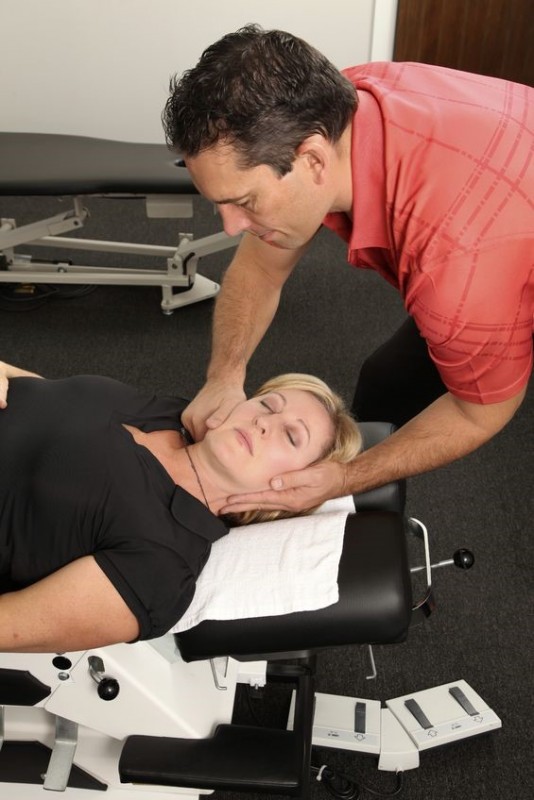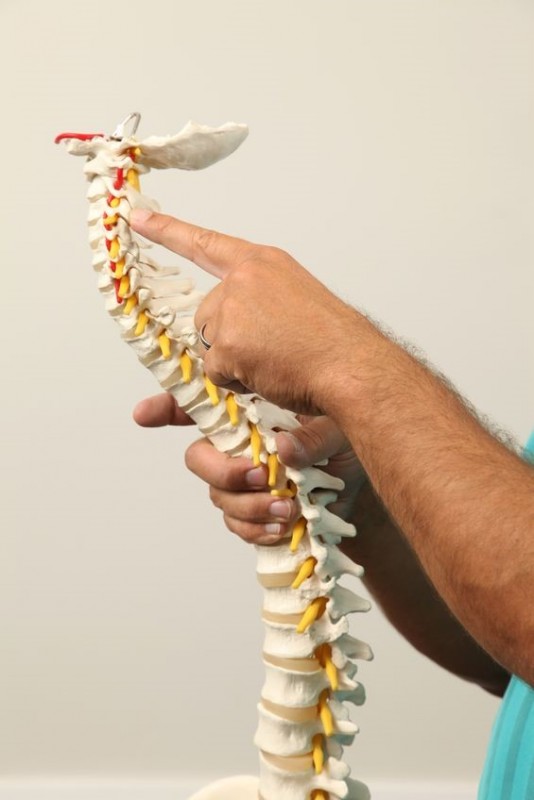
Chiropractic is an alternative treatment that uses hands-on spinal manipulation and also helps with misalignments of joints.
Why go to a chiropractor?
Misalignments of the joints can lead to disorders by affecting the nerves, muscles, and organs. By properly aligning the body's musculoskeletal structure, specifically the spine, the body may heal without surgery or medication.
 How well our bodies function is based on the integrity of our nervous system. The nervous system is the one system in our bodies that directly affects every other system. The explanation for this is your nerves conduct sensory information from every part of the body, and then deliver the information to your brain. When it arrives in your brain it analyzes the information to decide how to stay healthy.
How well our bodies function is based on the integrity of our nervous system. The nervous system is the one system in our bodies that directly affects every other system. The explanation for this is your nerves conduct sensory information from every part of the body, and then deliver the information to your brain. When it arrives in your brain it analyzes the information to decide how to stay healthy.
Chiropractors examine vertebral subluxations, which are misalignments of the spine and abnormal movement patterns of the vertebrae. When they fix vertebral subluxations multiple systems in the body notice it collectively. Chiropractic manipulates and adjusted the body, particularly the spinal column, relieving pressure on the nerves.
 Many chiropractors today are covered by health insurance which makes it a very cost-effective solution.
Many chiropractors today are covered by health insurance which makes it a very cost-effective solution.
Many patients who visit a chiropractor for musculoskeletal conditions often end up noticing non-musculoskeletal benefits as well. These benefits include improved respiratory, digestive function, vision, and circulation. In another study, chiropractic adjustments were shown to decrease blood pressure preventing heart attacks and strokes. Finally, many chiropractors work to care for the person as a whole from general wellness to disease prevention.
While Chiropractic has mainly focused on spinal manipulation in the past, it now includes a variety of treatments. These treatments include manual or manipulative therapies, posture, stretches, exercise information, strengthening counseling, nutritional counseling, supplements, custom orthotics, ultrasounds, and laser therapies.
There is a growing number of research studies and reviews that show the treatment provided by chiropractors are clinically effective and safe. You can read more about this on the American Chiropractic Association website. However, just like with any other doctor or treatment, there are bad doctors out there, so make sure you do some research to find a good one.
 Many people think of back pain and maybe neck pain when they think of chiropractic treatment, but chiropractic actually helps with any joint pain that is ongoing, lasting months. Injuries not fixed by physical therapy could be joint issues which chiropractic treats. Chiropractic can help with back, arm, wrist, leg, knee, neck, shoulder, foot, and ankle pain.
Many people think of back pain and maybe neck pain when they think of chiropractic treatment, but chiropractic actually helps with any joint pain that is ongoing, lasting months. Injuries not fixed by physical therapy could be joint issues which chiropractic treats. Chiropractic can help with back, arm, wrist, leg, knee, neck, shoulder, foot, and ankle pain.
Other Conditions Chiropractic helps with include: Arthritis, Headaches, Traumatic injuries, Allergies, Asthma, Sleep Issues, PMS, ADHD, Colic, Pinched Nerves, Pregnancy, Stress, Depression, and Wellness.
Musculoskeletal Conditions Chiropractic helps with include: Carpal Tunnel Syndrome, Plantar Fasciitis, Epicondylitis, Tendinitis, Strains, Fractures, Ligament Injuries, Myelopathy, Whiplash, Complex Regional Pain Syndrome, Strokes, Dislocation, Frozen Joints, Muscle/Ligament/Joint Tears and Pulls, Herniated Discs, Scoliosis, Medial Tibial Stress Syndrome, Osteoarthritis, Ruptured Discs or Tendons, Scurvy, Shin Splints, Fibromyalgia, and Chronic Discomfort.
Chiropractic Care for Back Pain
 Experts estimated that as much as 80% of the population will deal with some form of back pain in their lives. Most causes of back pain are not caused by any serious conditions like arthritis or a car accident. Back pain is one of the most common reasons for missed work and the second most common reason for visits to the doctor’s office. Half of all working Americans admit to having back pain symptoms each year. You can view more of these statistics on the American Chiropractic Association website.
Experts estimated that as much as 80% of the population will deal with some form of back pain in their lives. Most causes of back pain are not caused by any serious conditions like arthritis or a car accident. Back pain is one of the most common reasons for missed work and the second most common reason for visits to the doctor’s office. Half of all working Americans admit to having back pain symptoms each year. You can view more of these statistics on the American Chiropractic Association website.
Chiropractic Care for Wellness
Many seek out chiropractic even when they are not in any pain. Chiropractic is great for general wellness because you can fix small problems before they turn into serious problems. Vertebral subluxations can exist without any pain and can get worse over time leading to noticeable pain.
Chiropractors will perform a physical examination to diagnose your condition. They will then create a customized treatment plan. The treatment plan may include mobilization therapy, adjustments, light therapy, ultrasound therapy, hydrotherapy, TENS, Diathermy, cold laser treatment, interferential current, and roller or traction table treatment.
Spinal Manipulative Therapy (SMT) is one of the most widely used treatments for back pain, especially lower back pain. Read more about: Spinal manipulative therapy for the treatment of low back pain.
Low back pain is a common disabling disorder, which can significantly reduce an individual's general mobility and overall wellbeing [1] . Spinal manipulative therapy (SMT) is the most widely used non-pharmacological intervention for low back pain, and its efficacy is supported by numerous randomised controlled trials whose results form the basis for clinical guidelines [2-5].
Chiropractic treatment is not a new treatment option. The earliest recordings of spinal corrections date back 4000 years and were recorded in Ancient Chinese on turtle shells. Evidence suggests that spinal treatment came way before medical care and was a preferred healing option during most of mankind’s civilized existence. In 1500 B.C., the Greeks recorded their success in low back treatment. Hippocrates known as the “Father of Medicine” wrote “Get knowledge of the spine, for it is the requisite for many diseases.” He had many writings and manuscripts including “Setting Joints By Leverage” written in 500 B.C.
Chiropractic became an official treatment option in 1895 when DD Palmer performed the first chiropractic adjustment. He helped a janitor who suffered hearing loss restore his hearing. Although numerous forms of manipulation had been used for hundreds or even thousands of years, there was no philosophical or scientific reasoning to explain the results until Palmer’s contributions. He formed the philosophy, art, and science of chiropractic based on his comprehensive studies in anatomy and physiology.
Today, there are more than 70,000 active chiropractic licenses in the United States. Many other countries utilize chiropractic care too including Mexico, Great Britain, Canada, Australia, Switzerland, and Japan.
There are a wide variety of chiropractic techniques. Some doctors are hands-on only, and others will use devices or instruments for joint manipulation. In addition, some chiropractors are very gentle while others will be quick and firm with their treatment.
Some people enjoy the feeling of relief when hearing “joints popping.” Others are bothered by the thought of it and would prefer a lighter, gentler treatment. Some chiropractors work in coordination with other professions such as acupuncturists or massage therapists, and some just offer chiropractic care. So do some research to find a chiropractor that is right for you.
 To become a chiropractor in the U.S., it is not always required to obtain a bachelor’s degree. However, usually about 90 undergraduate credits are required. It depends on the state. The next requirement is to attend an accredited chiropractic college for a four-year degree. This will typically include about 4,200 hours of classroom, lab work, and clinical internship experience. The number of classroom hours is around the same as the requirements to become a general medical doctor (MD) or osteopath (DO). In some areas of anatomy, physiology, rehabilitation, nutrition and public health, chiropractors receive more intensive education than MD’s. (American Chiropractic Association).
To become a chiropractor in the U.S., it is not always required to obtain a bachelor’s degree. However, usually about 90 undergraduate credits are required. It depends on the state. The next requirement is to attend an accredited chiropractic college for a four-year degree. This will typically include about 4,200 hours of classroom, lab work, and clinical internship experience. The number of classroom hours is around the same as the requirements to become a general medical doctor (MD) or osteopath (DO). In some areas of anatomy, physiology, rehabilitation, nutrition and public health, chiropractors receive more intensive education than MD’s. (American Chiropractic Association).
U.S. Certification and Licensing Requirements
Once a person obtains their Doctor of Chiropractic Degree, they need a certification and license to practice. In order to gain a certification, they much pass a national board exam governed by the National Board of Chiropractic Examiners (NBCE). Then, a license must be obtained in the state they would like to practice. In addition, there is usually continuing education yearly to keep the license. Some chiropractors will specialize in sports injuries, geriatrics, or pediatrics. Many chiropractors will also provide naturopathy, essential oils, massage, myofascial release therapy, or other alternative treatments.
 At your first chiropractic appointment, you will fill out your health history and a questionnaire related to your pain symptoms. Then depending on the chiropractor, you may do a test where you stand on a scale and they get a report of your fat to muscle ratios among other things. The chiropractor will also assess your range of motion, reflexes, and muscle strength. They will then talk to you about your pain areas and answer any questions you might have. If the chiropractor feels that he or she can help you, they will probably do a few adjustments at your first appointment. A good chiropractor will not treat someone, if they know it could be harmful due to a past injury.
At your first chiropractic appointment, you will fill out your health history and a questionnaire related to your pain symptoms. Then depending on the chiropractor, you may do a test where you stand on a scale and they get a report of your fat to muscle ratios among other things. The chiropractor will also assess your range of motion, reflexes, and muscle strength. They will then talk to you about your pain areas and answer any questions you might have. If the chiropractor feels that he or she can help you, they will probably do a few adjustments at your first appointment. A good chiropractor will not treat someone, if they know it could be harmful due to a past injury.
How long do Adjustments take? How often are Adjustments?
The first visit maybe 30 minutes or more. Regular visits after the first appointment will typically take around 10 to 15 minutes. Adjustments are done while you are sitting upright, on your side, lying face down, or on your back. You may not feel immediate relief with your first adjustment. It may take a few appointments or more to feel definite improvements. It all depends on your condition. It also depends upon how well you take care of your back or pain areas outside of appointments. Depending on the level of pain, treatments can be once to twice a week. As you improve, sessions will be once a month to six weeks. Once the major pain issues are addressed, you can choose whether to continue to go for general wellness visits or wait till a pain issue comes up again.
Scientific Research to Support Chiropractic Care
There are many clinical research studies showing the effectiveness of chiropractic treatment for spine-related injuries, low back pain, neck pain, headaches, spinal manipulation in general, and more.
 In the March/April 2007 issue of the Journal of Manipulative and Physiological Therapeutics, the researchers reviewed nine previously published trials and found “high-quality evidence” that patients with chronic neck pain showed significant pain-level improvements following spinal manipulation. (ACA) Also, all groups showed positive improvement even 12 weeks after treatment. There are several more studies like this one on the American Chiropractic Association website.
In the March/April 2007 issue of the Journal of Manipulative and Physiological Therapeutics, the researchers reviewed nine previously published trials and found “high-quality evidence” that patients with chronic neck pain showed significant pain-level improvements following spinal manipulation. (ACA) Also, all groups showed positive improvement even 12 weeks after treatment. There are several more studies like this one on the American Chiropractic Association website.
Here are some other research studies:
- ScienceDirect has a randomized controlled trial of the effectiveness of chiropractic treatment for migraines.
- The International Chiropractic Pediatric Association has a comprehensive collection of research studies, chiropractic case studies and other published papers which show the efficacy of chiropractic care for children and pregnant women. (ICPA)
- ChiroACCESS has two studies showing medical research supports chiropractic maintenance care.
- Dr. ERICZ has 10 chiropractic research studies on neck, back, leg pain, and more.
ICPA/ICPA Peer Reviewed Published Papers and Current Projects
Retrieved from http://icpa4kids.org/About-the-ICPA/icpa-research.html
Gentile, Julie (2016, December). Spine Universe/Chiropractic Care for Chronic Pain. Retrieved from:
https://www.spineuniverse.com/conditions/chronic-pain/chiropractic-care-chronic-pain
DOCSHOP/Conditions Commonly Treated by Chiropractors. (2017, September) Retrieved from:
https://www.docshop.com/education/chiropractic/conditions-treated
Harvard Health Publishing/Harvard Medical School. (2016, February) Retrieved from:
https://www.health.harvard.edu/pain/chiropractic-care-for-pain-relief
American Chiropractic Association/What Research Shows About Chiropractic:
https://www.acatoday.org/Patients/Why-Choose-Chiropractic/What-Research-Shows
Andrews, Kelly (2013, August) SPINE-Health/Questions to Ask About Chiropractic Techniques. Retrieved from:
https://www.spine-health.com/treatment/chiropractic/questions-ask-about-chiropractic-techniques?platform=hootsuite
Grassi, Ron. spine universe/The History of Chiropractic. Retrieved from:
https://www.spineuniverse.com/treatments/chiropractic/history-chiropractic
Chiropractic Association of Ireland/Chiropractic History. Retrieved from:
http://www.chiropractic.ie/about-cai/info/chiropractic-history
FOXNEWS Health/How can chiropractors benefit your health? (2012, May) Retrieved from:
http://www.foxnews.com/health/2012/05/02/how-can-chiropractors-benefit-your-health.html
American Chiropractic Association/Back Pain Facts and Statistics - Retrieved from:
https://www.acatoday.org/Patients/Health-Wellness-Information/Back-Pain-Facts-and-Statistics
